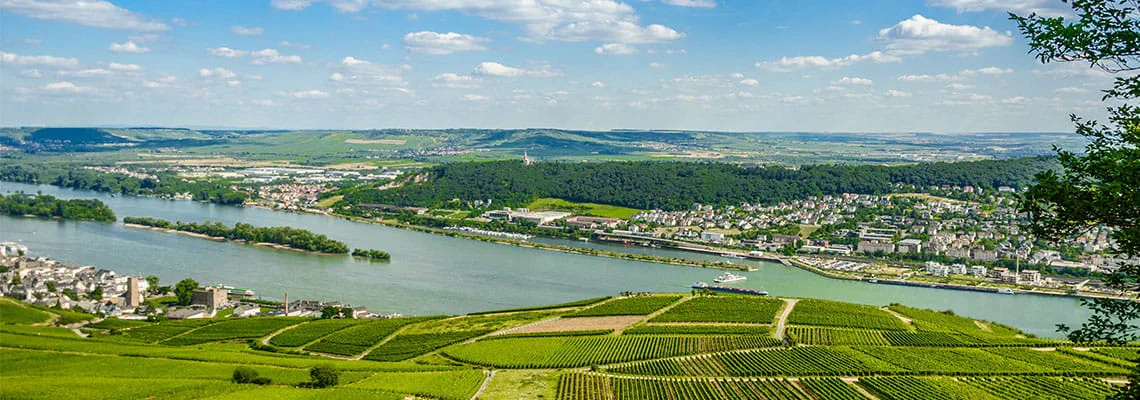|
Table of contents |
|---|
Our essential guide to Water Resource Management. Climate change and human activity mean we are facing a challenging task in an unpredictable environment.

Image credit: American Press Association
Water management today is not what it was five, 10 or even 20 years ago. Challenges such as climate change coupled with the effects of human activity mean those responsible for managing water resources have a more challenging task on their hands in an even more unpredictable environment. As a result, private and public stakeholders must collaborate to help develop ways to manage water cycle collectively, as a whole. Water resources management enables the effective management of water resources across all water uses, disciplines and even boundaries. The following article will provide everything you need to know about water resources management: what it means, objectives, drafting policies and more.
What is water resource management?
Water Resources Management (WRM): Where teamwork makes the dream work IWA
The UN states that Water Resources Management (WRM) and Integrated Water Resources Management (IWRM) is an empirical concept which was built up from the on-the-ground experience of practitioners. Although many parts of the concept have been around for several decades - in fact since the first global water conference in Mar del Plata in 1977 - it was not until after Agenda 21 and the World Summit on Sustainable Development in 1992 in Rio that the concept was made the object of extensive discussions as to what it means in practice.
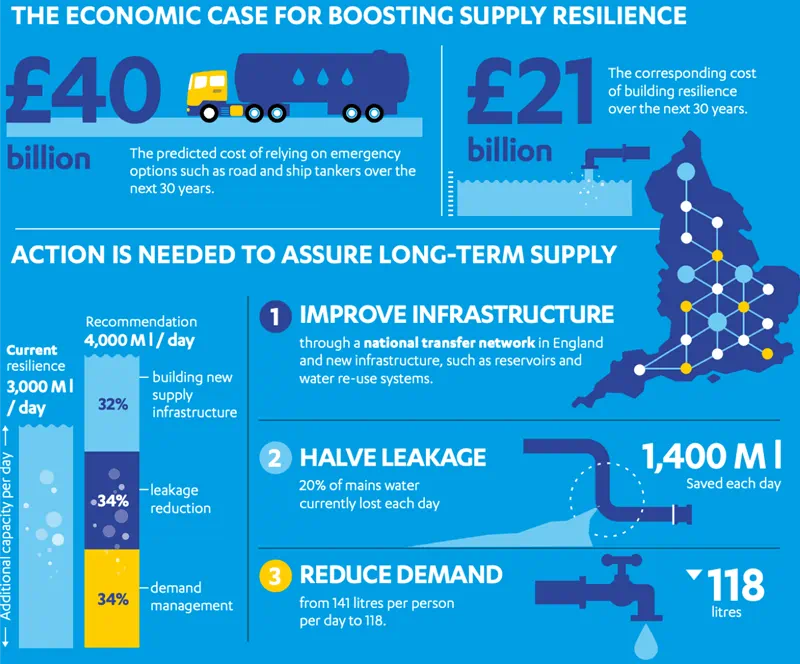
Image credit: International Water Association
The IWRM principles adopted at the International Conference on Water and the Environment in Dublin, Ireland, in 1992, are known as the Dublin Principles.
These principles were later summarized by GWP:
“Integrated water resources management is based on the equitable and efficient management and sustainable use of water and recognises that water is an integral part of the ecosystem, a natural resource, and a social and economic good, whose quantity and quality determine the nature of its utilisation.”Meanwhile the World Bank defines WRM as the “process of planning, developing, and managing water resources, in terms of both water quantity and quality, across all water uses”. It includes the institutions, infrastructure, incentives, and information systems that support and guide water management.
According to the World Bank, water resources management seeks to harness the benefits of water by ensuring there is sufficient water of adequate quality for drinking water and sanitation services, food production, energy generation, inland water transport, and water-based recreational, as well as sustaining healthy water-dependent ecosystems and protecting the aesthetic and spiritual values of lakes, rivers, and estuaries.
Water resource management also entails managing water-related risks, including floods, drought, and contamination. The complexity of relationships between water and households, economies, and ecosystems, requires integrated management that accounts for the synergies and tradeoffs of water's great number uses and values.
One of the goals of water resource management is water security. It is not possible to ‘predict and plan’ a single path to water security for rapidly growing and urbanizing global populations. This is due to climatic and non-climatic uncertainties. To help strengthen water security, there is a need to build capacity, adaptability and resilience for the future planning and management of water resources.
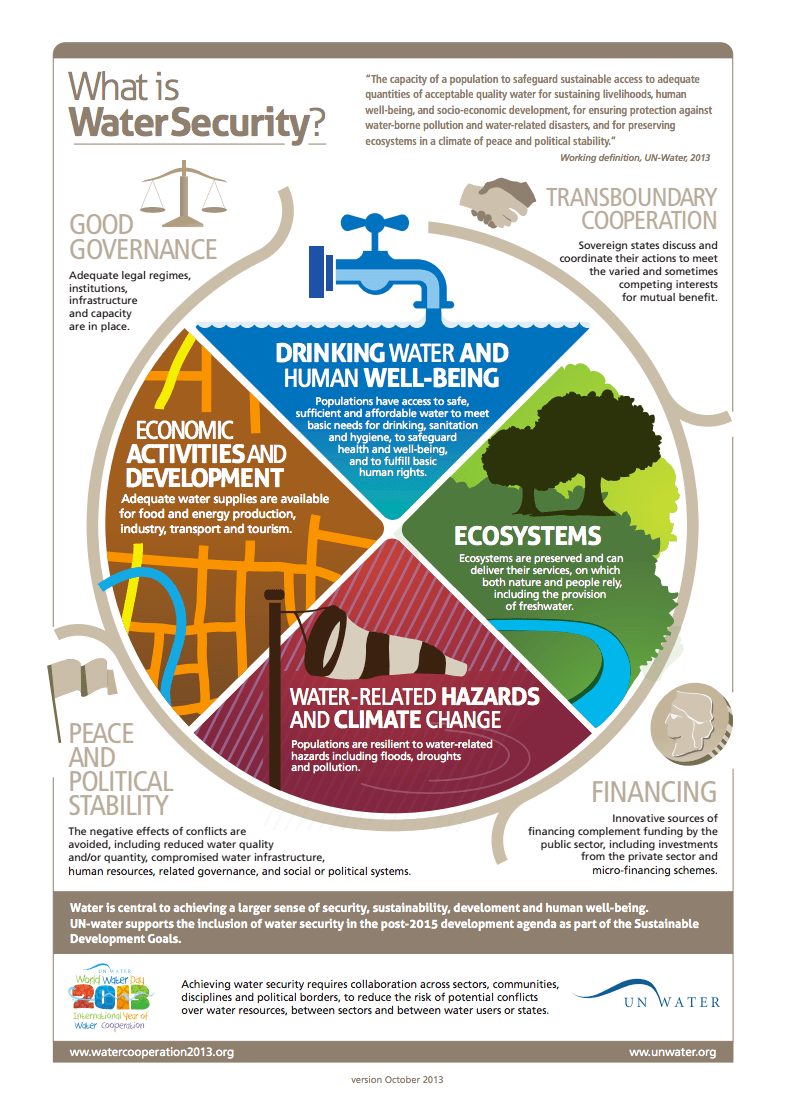
Image credit: UN Water
According to the World Bank, achieving water security in the context of growing water scarcity, greater unpredictability, degrading water quality and aquatic ecosystems, and more frequent droughts and floods, will require a more integrated and longer-term approach to water management. This is in essence what water resource management is about: bringing together multiple organisations, across different disciplines to plan for future water usage holistically.
Objectives of water resource management
Depending on the region and state of current water conditions, policy and implementation, water resource management objectives can vary.
However, often Water Resources Management objectives can include promoting conditions for environmentally sustainable, economically efficient and equitably allocated use of water resources. They also include to increase the benefits and reduce the risk related to existing hydraulic infrastructure.
Throughout these projects, a common objective is to integrate policy approach within other sectoral policies in a wider area across the country. This includes often developing social, technical and administrative water resource management tools.
According to the GWP, an IWRM approach focuses on three pillars:
- an enabling environment of suitable policies, strategies and legislation for sustainable water resources development and management,
- putting in place the institutional framework through which to put into practice the policies, strategies and legislation, and
- setting up the management instruments required by these institutions to do their job.
Water resource management policy
When it comes to drafting water resource management policy, it's important to have a clear understanding of what policy is and is not. Not to be confused with implementing strategies, policy is a set of decisions, made at the highest political level in a country following dialogue and consultation. The result will then shape and determine how things will be done in any given sector.
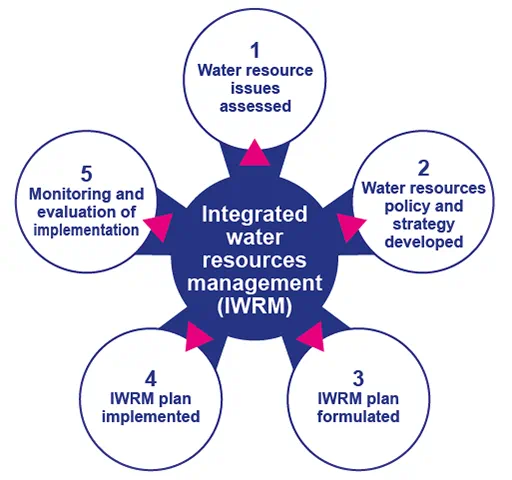
Image credit: The Open University
Within water resource management, a key component is not only the policy, but a process or plan on how to implement such a policy. Furthermore, policy should not be confused with legislation. After a policy has been adopted, legislation needs to be examined to see where amendments and changes are needed.
According to the OECD, water outcomes are often influenced by policies outside the water domain. As a result, increasing unity between water policies and other sectoral policies is a key component of an integrated approach to water resources management.
Furthermore, there is no one size fits all approach, nor one correct administrative model.
The GWP said: “The art of IWRM lies in selecting, adjusting, and applying the right mix of tools for a given situation. Agreeing on milestones and timeframes is critical for success. The implementation may take place on a step-by-step basis, in terms of geographical scope and the sequence and timing of reforms. Scope, timing, and content of measures can be adjusted according to experience. In developing a strategy and framework for change, it is important to recognize that the process of change is unlikely to be rapid.”
For policy-making and planning, in order to obtain an integrated approach it’s important that water development and management takes into account the various uses of water and the range of people’s water needs, including:
- Stakeholders are given a voice in water planning and management, with particular attention to securing the involvement of women and the poor;
- Policies and priorities consider water resources implications, including the two-way relationship between macroeconomic policies and water development, management, and use;
- Water-related decisions made at local and basin levels are along the lines of, or at least do not conflict with, the achievement of broader national objectives; and
- Water planning and strategies are incorporated into broader social, economic, and environmental goals.
GWP added: “Putting sustainable and integrated management of water resources into practice must be anchored at all levels with the highest political commitment.”
Hydrology and water resources management
Hydrology is the study of the global water cycle and the physical, chemical, and biological processes involved in the different reservoirs and fluxes of water within this cycle. In general, hydrologists focus on terrestrial water, while recognizing that the global hydrological cycle includes exchanges of water between the land surface, ocean, atmosphere, and subsurface. Meanwhile water in the oceans and atmosphere is mainly the concern of oceanographers and meteorologists. Many hydrologists work at the interface between land surface water and the atmosphere, studying precipitation and evapotranspiration processes in the field of hydrometeorology.
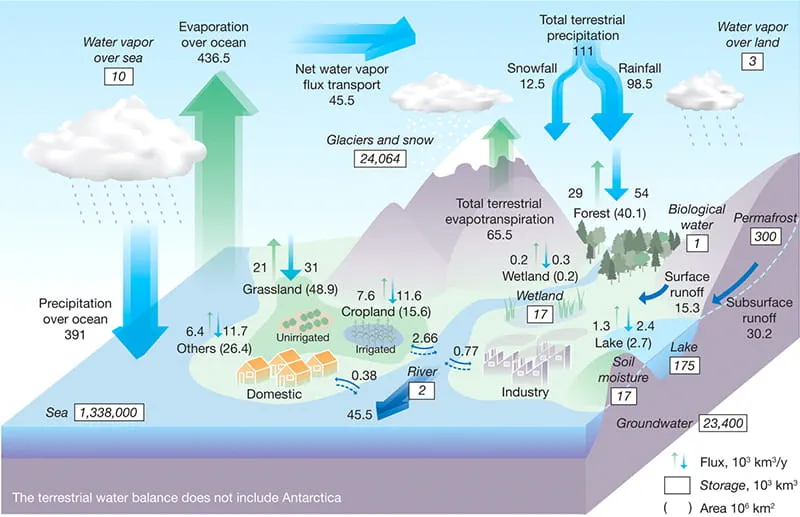
Image credit: Science
Water resource management includes consideration of several disciplines of hydrology, including the global water cycle, surface water and groundwater, water chemistry and pollution and aquatic biology. This is according to S.J. Marshall in his Hydrology module in Earth Systems and Environmental Sciences.
After treatment, water supplies are sent to meet a range of requirements including industrial, municipal, agricultural and ecological. While some of these water uses take water from the system and can be classed as "consumptive", others return water after use but to a lesser quality. This water often requires treatment to return it back to a natural state and sometimes this is not possible, for example an industrial tailings pond.
The balancing act involved in water management includes a broad range of stakeholders and includes water policy and legal experts. Hydrologists have essential input to these complex and sometimes confrontational deliberations and negotiations. They also play a central role in applied hydrology – engineering of major waterworks to manage water. Water distribution systems have been a hallmark of civilization since Babylon, and the modern stamp on this includes major hydroelectric dams and reservoirs, urban waterworks, and water treatment facilities.
These and other tools help governments to manage water resources in a way that serves societal and ecological needs.
According to Marshall, water resource management is one of the world’s greatest challenges due to competition for limited resources, regional disparities in water supply and affluence, mounting global water demand, aquifer depletion, and pollution- and climate-change-induced water stress. Integrated sustainable water resource management is an area requiring innovation, progress, and international cooperation in the coming decades.
Water resource management strategies: 3 case studies
To help understand what can be achieved with effective water resource management strategies, it’s important to reference case studies where programmes have been implemented. Below are three case studies ranging in scale and ambition:
Water utility level: 25 years and beyond at United Utilities

Image credit: Affinity Water
UK water utilities are required to submit statutory a Water Resources Management Plan (WRMP) every five years to set out its intended approach for at least the next 25 years. The UK water utility documented its revised draft Water Resources Management Plan 2019 (rdWRMP19), which was developed following consultation on a draft Water Resources Management Plan, held in spring 2018. The plan defines a strategy to achieve a long-term, best value and sustainable plan for water supplies in the North West to ensure adequate supply to meet demand over the 25 years from 2020 to 2045. In the document UU proposed leakage reduction activities with the target to deliver 15% leakage reduction by 2025 and just over 40% reduction by 2045. Drought resilience was also a key feature, with UU saying it has tested its system to "droughts that are more severe or extreme than historically experience". The utility said it has a "resilient system that is able to withstand at least a 1 in 200-year event (that has a 0.5% annual risk”.
Regional level: Integrated Water Resources Management in Eastern Europe, the Caucasus and Central Asia
In the countries of Eastern Europe, the Caucasus and Central Asia, competition for water resources had been intensifying, driven by increasing demands from agriculture, energy producers, industry and cities. There was a need to ensure such competing demands were met by a robust policy framework and internationally recognised principles of integrated water resources management. After joined up efforts, there is evidence that the region was increasingly applying the principles of IWRM. This included the revision of water codes, the organization of river basin councils and the development of river basin management plans, as well as an increasing reliance on economic instruments to manage water demand and to cover the costs of water services.
City-state level: A sustainable approach to water resource management in Singapore
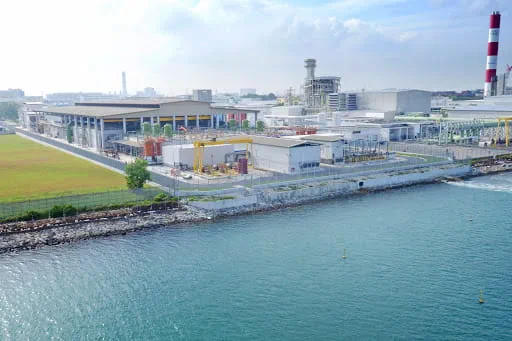
Image credit: Global water Tech Hub Alliance
An island city-state off southern Malaysia, Singapore is a single water agency, known as PUB. The water company manages the complete water cycle, from collecting, treating and supplying drinking water, to the collection and treatment of used water and turning it into NEWater. Singapore set out its approach to water resource management using a ‘3 P’3 approach in parallel with its ‘Four National Taps’ development: local catchment water, imported water, NEWater and desalinated water. The city-state now has a diversified water system: multiple desalination plants in operation, together with water reclamation, recently outlining increased treatment capacity at the Jurong Water Reclamation Plant and the Changi Water Reclamation Plant.
Aquaculture and water resource management
Aquaculture is defined as the breeding, rearing and harvesting of fish, shellfish, plants, algae and other organisms in all types of water. While this may seem distant from the water supply for consumption, agriculture and industry, it can be linked via water resource management.

Image credit: Medium
A wide range of organisms are supported by Aquatic ecosystems, including insects, fish, invertebrates and microorganisms. Tech biodiversity of aquatic systems is a major concern in many water conservation and restoration projects.
Understanding trophic systems and their health as a function of environmental conditions, including water turbidity and temperature, is the responsibility for some hydrologists.
Water plays an important role in both agriculture and aquaculture, as great quantities of water are used in both processes. As a result, water used in both agriculture and aquaculture has to be of sufficient quality so as not to be damaging to human health.
Meanwhile, aquaponics uses wastewater produced by facilities that raise fish or other marine animals to supply nutrients for plants that are grown hydroponically (without soil). The plants, in turn, purify the water, which is then returned to the marine animals.

Image credit: Wisconsin State Farmer
One notable case study is the National Oceanic and Atmospheric Administration’s Sea Grant Program, supporting efforts to operate the largest aquaponics operation in the world. The 123,000 square-foot greenhouse, located in Wisconsin, harvests various types of greens. Water from an adjoining facility that raises salmon and rainbow trout is pumped to the greenhouse through underground pipes. The plants cleanse the water of ammonia, which is harmful to the fish. Purified water is then recirculated back to the fish-farming facility.
Related content
- A phoenix from the drought? Chennai to reignite desalination
- Water reuse staggers ahead in Europe following council boost
- Mexico City mayor pledges water for all by 2024
- Global rivers contaminated with antibiotics, finds new research
- Flood defences not enough to win ‘war against water’
- China assigns more funds to improve water quality as 2020 deadline looms
- Explore all our coverage related to water treatment

